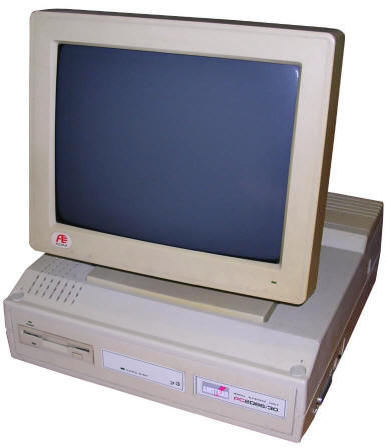Amstrad PC2086/30
After success of PC1512/1640 line, Amstrad decided to
continue their line of PC-compatible computers. The next iteration of
Amstrad XTs was released in 1988 as PC 2086, and later 2286 and 2386
with better CPUs and bigger RAM. As in 1512, PC2086 has 8086 processor,
but it has full 640kB of memory and VGA graphics chip on board. 5.25"
floppy disk drive has been replaced with 3.5" drive with enhanced
controller which could support even high-density disks. Some units have
XTA interface on ISA board to connect hard drive. Most units have hard
disks, the popular model 2086/30 has a drive formatted to 30MB using RLL
controller.
The computer still has custom keyboard and mouse interface, preserved
from PC1xxx line, but the connector is different and keyboards have more
keys. The case has been re-vamped to be similar to all-in-one PCs
popular in some business sectors. However it is still a modular PC with
monitor going nicely to protrusions in casing. Power supply unit is in
the computer and this time engineers decided to include a fan inside.
The machine was sold both in UK and in the Europe, mostly in Germany.
| Manufacturer | Amstrad | |
| Origin | UK | |
| Year of unit | 1988 | |
| Year of introduction | 1988 | |
| Class | XT | |
| CPU | 8086 | |
| Speed | 8MHz | |
| RAM | 640kB | |
| ROM | Amstrad's BIOS | |
| Graphics | Paradise VGA Max 640x480x256 |
|
| Sound | PC Speaker | |
| System expansion bus | 8-bit ISA (3 slots + 1 for HDD controller)
|
|
| Floppy/removable media drives | Internal: one 3.5"
floppy disk drive, 720kB External drive and power connector, Possible to install high-density drives? |
|
| Hard disk: | 30MB RLL (ST412 interface) | |
|
Peripherals in collection: |
||
| Other boards:
|
None | |
| Non-standard expansions: | - | |
| Operating system(s): | MS-DOS |
My unit comes from e-waste and I don't know about its history as I
dont have a keyboard for it. It seems to pass the POST except hard disk,
detect lack of keyboard, then it halts. Theoretically it may be possible
to use, in a limited degree, Model PC1512 keyboard with some adapter.
The only thing I know is that someone tried to remove the "30" mark from
the casing.
| Contents: | Starting, usage | Configuration | Pinouts | Links |
Starting
The computer boots from floppy disk drive. By using a switch on the side you can switch the external drive or use internal one. If there is no floppy to boot from, it boots from hard disk, the controller board, sometimes RLL, sometimes XT-Attachment, is in the fourth ISA slot, not accessible from the rear of casing.
According to
this site
(1 - ON (pressed down), 0 - OFF):
SW1,2 - External graphics card type:
00 - EGA/VGA
01 - CGA, 40-column mode
10 - CGA, 80-column mode
11 - MDA, 80-column mode.
SW3 - 1 disables built-in serial port. Useful when you have external serial port card or modem.
SW4 - 1 disables on-board VGA chip
SW5 - 1 to modify video output to display better picture on multisync-type monitor
SW6 - 1 turns on automatic monochrome/color switching based on program requirements.
SW7,8 - Reserved, 00 by default.
Near CPU there are jumpers for memory size, they are labeled on mainboard. There are also jumpers for BIOS size.
The hard disk installed in my unit, Western Digital WD383R, is especially designed for RLL formatting. Its geometry is 615/4/26 (C/H/S). The controller is WD1004A-27X which can be configured with other geometries for disks.
Keyboard according to
this site:

1 - CLOCK
2 - DATA
3 - M1
4 - GND
5 - +5V
6 - M2
7 - LOCK?
M1 and M2 are mouse buttons, passed from mouse connector. Mouse buttons
are interpreted as keyboard scancodes. Mouse pinout can be seen in
Amstrad PC1512 page, it is
probably the same or similar. Check Vcc/GND before trying.
http://web.archive.org/web/20081209011809/http://web.ukonline.co.uk/cliff.lawson/files.htm
- Windows driver do download, unfortunately may require replacing CPU
with V30
http://www.retroisle.com/amstrad/pcs/software.php - Another GEM and
Windows drivers, worth trying
http://www.seasip.info/AmstradXT/pc2086dip.html - DIP Switch /
option links configuration
http://computers.popcorn.cx/amstrad/pc2086/ - In collection
http://www.seasip.info/AmstradXT/pc2086kbd.html - Keyboard pinout
and keycodes diagram





